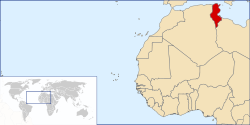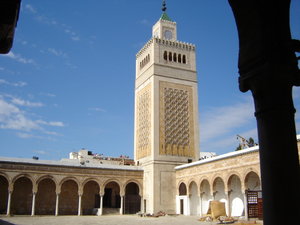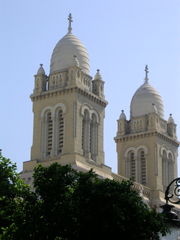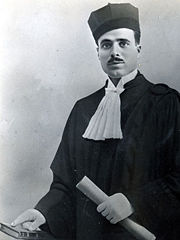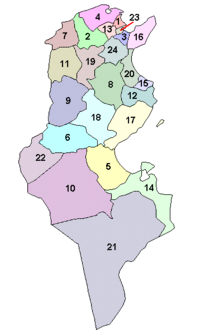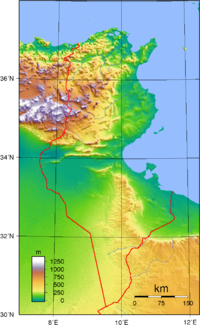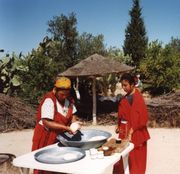Tunisia
2008/9 Schools Wikipedia Selection. Related subjects: Africa; African Countries
| الجمهورية التونسية Al-Jumhūriyyah at-Tūnisiyyah Tunisian Republic
|
||||||
|---|---|---|---|---|---|---|
|
||||||
| Motto: حرية، نظام، عدالة (Hurriya, Nidham, 'Adala) "Liberty, Order, Justice" |
||||||
| Anthem: Himat Al Hima |
||||||
|
|
||||||
| Capital (and largest city) |
Tunis |
|||||
| Official languages | Arabic | |||||
| Demonym | Tunisian | |||||
| Government | Republic | |||||
| - | President | Zine El Abidine Ben Ali | ||||
| - | Prime Minister | Mohamed Ghannouchi | ||||
| Independence | ||||||
| - | from France | March 20, 1956 | ||||
| Area | ||||||
| - | Total | 163,610 km² ( 92nd) 63,170 sq mi |
||||
| - | Water (%) | 5.0 | ||||
| Population | ||||||
| - | July 2005 estimate | 10,102,000 ( 78th) | ||||
| - | 1994 census | 8,785,711 | ||||
| - | Density | 62/km² ( 133rd (2005)) 161/sq mi |
||||
| GDP ( PPP) | 2007 estimate | |||||
| - | Total | $ 97.74 billion ( 60th) | ||||
| - | Per capita | $9,630 ( 73rd) | ||||
| Gini (2000) | 39.8 (medium) | |||||
| HDI (2007) | ▲ 0.766 (medium) ( 91st) | |||||
| Currency | Tunisian dinar ( TND) |
|||||
| Time zone | CET ( UTC+1) | |||||
| - | Summer ( DST) | CEST ( UTC+2) | ||||
| Internet TLD | .tn | |||||
| Calling code | +216 | |||||
Tunisia (Arabic: تونس Tūnis, Amazigh: Tuns), officially the Tunisian Republic (الجمهورية التونسية), is a country situated on the Mediterranean coast of North Africa. It is bordered by Algeria to the west and Libya to the southeast. It is the northernmost African country and the smallest of the nations situated along the Atlas mountain range. Around forty percent of the country is composed of the Sahara desert, with much of the remainder consisting of particularly fertile soil, and a 1300 km coastline. Both played a prominent role in ancient times, first with the famous Phoenician city of Carthage, and later, as the Africa Province, which became known as the bread basket of the Roman Empire.
History
At the beginning of history, Tunisia was inhabited by Berber tribes. Its coast was settled by Phoenicians starting as early as the 10th century BC. The city of Carthage was founded in the 9th century B.C. by settlers from Tyre, now in modern day Lebanon. Legend says that Queen Elissa founded the city in 814 B.C., as retold in by the Greek writer Timaeus of Tauromenium. The settlers of Carthage brought their culture and religion from the Phoenicians and other Canaanites.
After a series of wars with Greek city-states of Sicily in the 5th century BC, Carthage rose to power and eventually became the dominant civilization in the Western Mediterranean. The people of Carthage worshipped a pantheon of Middle Eastern gods including Baal and Tanit. Tanit's symbol, a simple female figure with extended arms and long dress, is a popular icon found in ancient sites. The founders of Carthage also established a Tophet which was altered in Roman times.
Though the Romans referred to the new empire growing in the city of Carthage as Punic or Phoenician, the empire built around Carthage was an independent political entity from the other Phoenician settlements in the Western Mediterranean.
A Carthaginian invasion of Italy led by Hannibal during the Second Punic War, one of a series of wars with Rome, nearly crippled the rise of the Roman Empire. Carthage was eventually conquered by Rome in the 2nd century BC, a turning point which led to ancient Mediterranean civilization having been influenced mainly by European instead of African cultures. After the Roman conquest, the region became one of the granaries of Rome and was fully Latinized and Christianized. It was conquered by the Vandals in the 5th century AD and reconquered by the commander Belisarius in the 6th century during the rule of Byzantine emperor Justinian.
In the 7th century the region was conquered by Arab Muslims, who founded the city of Kairouan. Successive Muslim dynasties ruled, interrupted by Berber rebellions. The reigns of the Aghlabids (9th century) and of the Zirids (from 972), Berber followers of the Fatimids, were especially prosperous. When the Zirids angered the Fatimids in Cairo (1050), the latter sent in the Banu Hilal tribe to ravage Tunisia.
The coasts were held briefly by the Normans of Sicily in the 12th century and the following Arab reconquest made the last Christians in Tunisia disappear. In 1159, Tunisia was conquered by the Almohad caliphs. They were succeeded by the Berber Hafsids (c.1230 – 1574), under whom Tunisia prospered. In the late 16th century the coast became a pirate stronghold (see: Barbary States). In the last years of the Hafsids, Spain seized many of the coastal cities, but these were recovered by the Ottoman Empire. Under its Turkish governors, the Beys, Tunisia attained virtual independence. The Hussein dynasty of Beys, established in 1705, lasted until 1957.
French imperialism
In the mid-1800s, Tunisia's government under the rule of the Bey severely compromised its legitimacy by making several controversial financial decisions that led to its downfall. France began plans to take control of Tunisia when the Bey first borrowed large sums of money in an attempt to Westernize. This failing state facilitated the Algerian raids that occurred thereafter. The weakened Bey was powerless against these raids and unable to resist European colonization.
In 1878, a secret deal was made between the United Kingdom and France that decided the fate of the North African country. Provided that the French accepted British control of Cyprus, recently given to the United Kingdom, the British would in turn accept French control of Tunisia. This satisfied the French and led to their assumption of control in 1880, anticipating the Italians. Tunisia was formally made a French protectorate on May 12, 1881.
World War II
In 1942 – 1943 Tunisia was the scene of the first major operations by the Allied Forces (the British Commonwealth and the United States) against the Axis Powers (Italy and Germany) during World War II. The main body of the British army, advancing from their victory in Battle of el-Alamein under the command of British Field Marshal Montgomery, pushed into Tunisia from the south. The US and other allies, following their invasions of Algeria and Morocco in Operation Torch, invaded from the west.
General Rommel, commander of the Axis forces in North Africa, had hoped to inflict a similar defeat on the allies in Tunisia as German forces did in the Battle of France in 1940. Before the battle for Tunisia, the inexperienced allied forces had generally been unable to withstand German blitzkriegs and properly coordinate their operations. As such the battle for Tunisia was a major test for the allies. They figured out that in order to defeat Axis forces they would have to coordinate their actions and quickly recover from the inevitable setbacks the experienced German-Italian forces would inflict.
On February 19, 1943, General Rommel launched an attack on the American forces in the Kasserine Pass region of Western Tunisia, hoping to inflict the kind of demoralizing and alliance-shattering defeat the Germans had dealt to Poland and France. The initial results were a disaster for the United States; the area around the Kasserine Pass is the site of many US war graves from that time.
However, the American forces were ultimately able to reverse their retreat. Having learned a critical lesson in tank warfare, the Allies broke through the Mareth line on March 20, 1943. The allies subsequently linked up on April 8 and on May 2, 1943 the German-Italian Army in Tunisia surrendered. Thus, the United States, United Kingdom, Free French, and Polish (as well as other forces) were able to win a major battle as an allied army.
The battle, though often overshadowed by Stalingrad, represented a major allied victory of World War II largely because it forged the Alliance which would one day liberate Western Europe.
Independence
Before Western colonialism, Tunisia was ruled by a line of (Turkish colonial) Beys until 1881. Up until this point the Beys of Tunisia borrowed money from Europe to finance modernization within Tunisia. When the local population resented tax rises to fund the repayment the country found itself bankrupt. It is at this point that France, Britain and Italy placed the finances of Tunisia in administration via an international agreement.
Initially, Italy was the country that demonstrated the most desire to have Tunisia as a colony having investment, citizens and geographic proximity as motivation. However this was rebuffed when Britain and France co-operated to prevent this during the years 1871 – 1878 ending in Britain supporting French influence in Tunisia in exchange for dominion over Cyprus. France still had the issue of Italian influence and thus decided to find an excuse for a pre-emptive strike. Using the pretext of a Tunisian incursion into Algeria, France marched an army of about 36,000 personnel which quickly advanced to Tunis and forced the Bey to make terms in the form of the 1881 Treaty of Bardo (Al Qasr as Sa'id), which gave France control of Tunisian governance and making it a de-facto French protectorate.
Tunisia enjoyed certain benefits from French rule; however, the desire for self-governance remained and in 1910 Ali Bach Hamba and Bechir Sfar created the group of young Tunisians which led to the 1920 group called the “Destour” (constitution) party. Keeping the new movement under control led the French to use a combination of carrot-and-stick tactics that worked well but did not halt the momentum for independence. In 1934, a younger, more fervent element of the Destour party called the Neo-Destour emerged, with Habib Bourguiba, Dr Mahmoud Materi, Tahar Sfar and Bahri Guiga as their leaders. This new party was immediately declared illegal by the French administration, but received strong support from the fascist organizations of the Tunisian Italians.
Habib Bourguiba spent a great deal of time in French prisons. However, this did little to stem his influence or halt the momentum for change. The Second World War played into Bourguiba’s hands as he was moved from Vichy French prisons to Rome, and then to Tunisia as the Axis powers courted his influence in Tunisia. Bourguiba never endorsed these requests. He did manage relocation to Tunisia and two months after this, the Allies claimed Tunisia.
In the following ten years, the struggle for independence continued and gained momentum. Bourguiba was again incarcerated from 1952 – 1954, which in turn caused an outbreak of guerrilla attacks by supporters. In 1954, things changed abruptly when Pierre Mendes-France became the leader of the French government and pursued a policy of pulling out from burdensome French colonies, with Tunisia in this category. This resulted in the April 1955 agreement which handed internal autonomy to Tunisian hands while international relations were managed by France, a similar situation to the Turkish Bey method of governance in pre-1881.
The Neo-Destour were now in control, but Bourguiba refused to take the helm until the French relinquished all control over Tunisia. He did not have to wait long, as the terrible Algerian War of Independence changed the French desire for colonialism, leading to the abolition of the Treaty of Bardo and Tunisia gaining full independence in March 20, 1956.
Bourguiba became Prime Minister and, after 1957, the first president of the Republic of Tunisia as the constitutional role of the Bey was abolished.
Present-day politics
Tunisia is a republic with a strong presidential system dominated by a single political party. President Zine El Abidine Ben Ali has been in office since 1987, the year he deposed Habib Bourguiba in a bloodless coup. The constitution has been changed twice to allow Ben Ali to remain in power: initially from two to three terms, then from three to five. The ruling party, the Democratic Constitutional Rally (RCD), was the sole legal party for 25 years, known previously as the Socialist Destourian Party (PSD). The RCD still dominates political life.
Facing little opposition, the President is elected to 5-year terms. He appoints a Prime Minister and cabinet, who play a strong role in the execution of policy. Regional governors and local administrators also are appointed by the central government. Largely consultative mayors and municipal councils are elected. There is a unicameral legislative body, the Chamber of Deputies, which has 182 seats, 20% of which are reserved for the opposition parties. It plays a growing role as an arena for debate on national policy but never originates legislation. The Chamber virtually always passes bills presented by the executive with only one minor change. The judiciary is nominally independent but responds to executive direction, especially in political cases. The military is professional and does not play a role in politics.
Tunisia is noteworthy for its lack of public political discourse. Tunisia's precise political situation is hard to determine due to a strong level of silence and lack of transparency maintained by the government. There is compelling evidence that dissidents are routinely arrested, for crimes as minor as viewing banned web sites. There are currently six legal opposition parties all with their own newspapers. However, the Committee to Protect Journalists, in its 2005 country report on Tunisia, details a persistent record of harassment, persecution, imprisonment, and physical harm perpetrated on journalists critical of the government. Even Western journalists, when writing on Tunisian soil, are not spared this fate.
Despite official proclamations, the Tunisian government imposes significant restrictions on freedom of speech and human rights. As such Tunisians are noticeably insecure when discussing political matters. The internet, however, is the most immediately apparent sign of the pervasiveness of state control. In fact the growth of the internet has been a major issue for Tunisia. As tourism (mainly from Europe) has expanded in Tunisia, so has the number of Internet Cafes. Tunisian internet access is invariably censored. This censorship is targeted at material deemed pornographic as well as press or chat room commentary that is critical of the government. For example, the website of the Al Arabiya satellite channel is officially censored and thereby inaccessible from any computer in Tunisia.
Tunisia is also one of three Muslim countries (Azerbaijan and Turkey are the others), that prohibits the hijab in government buildings. By government edict, women that insist on wearing the hijab must quit their job. Dissenters are forced to sign a document admitting to having committed a crime punishable by law and, in cases of recidivism, are jailed. Women who insist on keeping their veils despite all threats become the subject of negative propaganda disseminated by the Tunisian authorities on all state and private media.
Underground opposition from Islamic Fundamentalists has an obvious but shadowy existence in Tunisia. Under former president Bourguiba, Islamic Fundamentalists were allowed to serve as a counterweight to more left-leaning movements. Zine al-Abidine Ben Ali, however, has followed an aggressive policy regarding the Fundamentalists, though the extent of government success is difficult to judge in a nation where so much is secret. While Tunisia has a repressive political system, standards of living are among the best in the developing world. This can be evidenced by two compelling economic observations: the level to which Tunisia has become self-sufficient in material goods, and the extent of real estate development in the cities and major towns of the country. Put simply, the mid-level retail outlet will typically offer goods more than 90% of which are home produced. As to the rise of the building and construction industry, a fleeting visit to any of Tunisia's smaller towns (let alone the cities) will confirm that development is rampant: many projects, especially hotels, are newly opened, and many more stand as skeleton buildings, ready to be developed as soon as demand - and capital funds - are available to bring them to completion. Tunisia remains an autocratic regime, but one where starvation, homelessness, and disease, problems seen in much of Africa and Asia, are rare.
The following is an excerpt from the The World Factbook about Tunisia;
Following independence from France in 1956, President Habib BOURGUIBA established a strict one-party state. He dominated the country for 31 years, repressing Islamic fundamentalism and establishing rights for women unmatched by any other Arab nation. In recent years, Tunisia has taken a moderate, non-aligned stance in its foreign relations. Domestically, it has sought to defuse rising pressure for a more open political society.
Governorates
Tunisia is subdivided into 24 governorates, they are:
|
|
The governorates are divided into 262 " delegations" or " districts" (mutamadiyat), and further subdivided into municipalities (shaykhats).
Geography
Tunisia is a country situated on the Mediterranean coast of North Africa, midway between the Atlantic Ocean and the Nile Valley. It is bordered by Algeria in the west and Libya in the south-east. An abrupt southern turn of its shoreline gives Tunisia two faces on the Mediterranean.
Despite its relatively small size, Tunisia has great geographical and climactic diversity. The Dorsal, an extension of the Atlas Mountains, traverses Tunisia in a northeasterly direction from the Algerian border in the west to the Cape Bon peninsula. North of the Dorsal is the Tell, a region characterized by low, rolling hills and plains, although in the northwestern corner of Tunisia, the land reaches elevations of 1,050 meters. The Sahil is a plain along Tunisia's eastern Mediterranean coast famous for its olive monoculture. Inland from the Sahil, between the Dorsal and a range of hills south of Gafsa, are the Steppes. Much of the southern region is semi-arid and desert.
Economy
Tunisia has a diverse economy, with important agricultural, mining, energy, tourism, petroleum, and manufacturing sectors. Governmental control of economic affairs, while still heavy, has gradually lessened over the past decade with increasing privatization, simplification of the tax structure, and a prudent approach to debt. Real growth averaged 5.0% in the 1990s, and inflation is slowing. Increased trade and tourism have been key elements in this steady economic growth. Tunisia's association agreement with the European Union (EU), the first such accord between the EU and a Mediterranean country, entered into force on March 1, 1998. Under the agreement Tunisia will gradually remove barriers to trade with the EU over the next decade. Broader privatization, further liberalization of the investment code to increase foreign investment, and improvements in government efficiency are among the challenges for the future of Tunisia. According to the British Philip's university atlas of 2000, Tunisia also possesses major phosphate reserves in the middle section of the country.
Tunisia is ranked most competitive economy of Africa in the 2007 edition of the Global Competitiveness Report that is released by the World Economic Forum. It also ranks first in the Arab World and 29th globally.
Demographics
The majority (98%) of modern Tunisians are Arab, and are speakers of Tunisian Arabic. However, there is also a small (1% at most) population of Berbers located in the Jabal Dahar mountains in the South East and on the island of Jerba. The Berbers primarily speak Berber languages, often called Shelha. The other long-established community in the country is Jewish (today mainly in the capital Tunis and on Jerba), much reduced in number since independence from France.
One study indicates that the majority of the genetic material in Tunisia did not arrive with the Arabs (no more than 20% was found to come from the Middle East, and most of this presumably was added by Phoenicians/ Carthaginians or as even early as the neolithic several millennia B.C. rather than during the Arab conquest). Another study, which does not compare Tunisian genetics with those of the Middle East, states that what it calls the Arab subhaplotype Va was found at a relatively high frequency in Tunisia at 50.6%. , but also states that this group in fact "probably correspond to a heterogeneous group representing various ethnicities", rather than just Arabs. Yet another finds that "the Tunisian genetic distances to European samples are smaller than those to North African groups" (these groups being from the Moroccan Atlas and the Siwa oasis in Egypt). This suggests a fairly significant European input to Tunisian genetics.
The first people known to history in what is now Tunisia were the Berbers. Numerous civilizations and peoples have invaded, migrated to, and been assimilated into the population over the millennia, with varying influxes of population via conquest and settlement from Phoenicians/ Carthaginians, Romans, Vandals, Arabs, Ottoman Turks, and French. Additionally, after the Reconquista and expulsion of non-Christians and Moriscos from Spain, many Spanish Moors and Jews also arrived at the end of the 15th century.
Religion in Tunisia is dominated by Islam, to which nearly all Tunisians (98%) adhere. In addition to the aforementioned Jewish population there is also a small indigenous Christian population. Small nomadic indigenous minorities have been mostly assimilated into the larger population.
Language
Modern Standard Arabic (MSA) is Tunisia's official language. However, as is the case in the rest of the Arab world, a vernacular form of Arabic is used by the public. In Tunisia, the dialect is Tunisian Arabic, which is closely related to the Maltese language. There is also a small minority of speakers of Shelha, a Berber language.
French also plays a major role in the country, despite having no official status. It is widely used in education (e.g. as the language of instruction in the sciences in secondary school), the press, and in business. Most educated Tunisians are able to speak it. Many Tunisians, particularly those residing in large urban areas, readily mix Tunisian Arabic with French.
Culture


